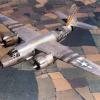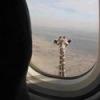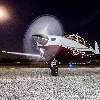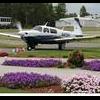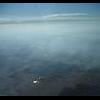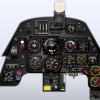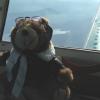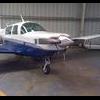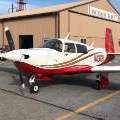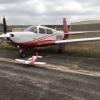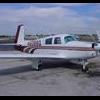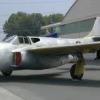Leaderboard
Popular Content
Showing content with the highest reputation on 06/03/2013 in all areas
-
Parachute is a sales gimmick. There was a pilot who lost gyros in the clouds pulled the chute and got no chute. He landed safely. Training saved him. Circus would have listed him as a "save" but the parachute failed. It is a gimmick for low time pilots and their wives to "feel" safe. Its existence only highlights the "I'm scared to fly cause its so unsafe" MYTH. Pure BS and way more money than I would ever spend for such a JOKE solution. PS tails don't fall off Mooneys you are thinking of Bonanzas and Saratogas. A good auto pilot and the knowledge to use it properly can help keep you ahead of the plane in busy situations. I consider it required equiptment for IFR operations.4 points
-
I'm pretty sure that we have been complimentary of other airframes, including Beech and Piper, for their various missions. It's amazing that this guy hasn't figured out that there are folks active on both forums. Seems that he's talking out of both sides of his mouth. So let me be very clear, skynewbie: no one here cares if you buy a Mooney. We aren't trying to talk you into or out of one over a Beech or anything else. As a matter of fact several have tried to talk you out of a Mooney. Add me to that list. Please don't buy a Mooney. Buy a Bonanza, or a Citation, or a Waco; I don't care. But please stay out of a Mooney. It doesn't fit your mission, you're not comfortable in one, and heck, you can't even fly a complex aircraft at this point. The perfect airplane for you at present for your local commute and training? I'd say a Skycatcher. Enjoy3 points
-
I'm not one to hang gadgets on every square inch of my panel. The single most cost effective "gadget" with the highest ROI on safety remains the training of the human in the left seat. I don't think anyone in their right mind would argue that. So be careful with your insinuations there Einstein! We have plenty of examples, unfortunately, where gadgets just don't save lives. Having said that, I think everyone should have a CO detector and a fire extinguisher. Also that poll with the list as presented contains "useful equipment" and "useless gadgets" all mixed in. Thus it makes no sense asking to select one. I was going to select yokes but you left them out! For example, an IFR GPS or extended range tanks or TKS, are useful equipment for certain applications, where an AOA ind is truly a useless gadget!3 points
-
Gadgets are great and most pilots are gadget geeks, but the single most cost effective safety enhancement you can add to your airplane is a well trained pilot. Take a page out of the pro's book and spend an hour or two every six months.3 points
-
I forgot to post these for you... After I had the new EI RPM gauge installed, I played with several RPM settings on the new gauge (me likey digital). (Throttle WO & ROP) Here is what my TAS looked like at the different RPM settings: 2400 RPMs: 2500 RPMS: 2700 RPMS (actually 2690 ) As I explained to Cruiser, no idea why my F is as strong as it is. It does have most of the J mods installed by a previous owner. Useful load is 960. It also has a strong powerplant -- always has been a great climber. Now that I have digital gauges for everything, I can't blame errors on the old stuff -- the new stuff matches the performance. Certainly isn't the CamGuard -- I don't use it. Certainly isn't LOP -- still haven't tried it. And it certainly isn't the Parrots -- had them for lunch. Yummy2 points
-
Just to continue the conversation, what would be the purpose of such section and why do you think that it would be useful? Older people talking to older people? That's why I came back from Florida.2 points
-
I would tell them to do something anatomically impossible and refi the plane with a better lender. I generally like my CU, but they wouldn't consider financing my plane, or refinancing it 5 years later, despite the fact they loan on big-ass RV's, boats, and other mobile, quickly-depreciating toys.2 points
-
A good auto pilot could keep some out of trouble and lower the workload. Shoulder + lap seat belts that aren't frayed and are on tight should minimize injury. But staying current/competent, avoiding real bad WX, having more fuel than you need in the tanks, keeping you eyes outside rather than buried in some gizmos, maintaing situational awareness, and not losing you cool and panicking when something goes wrong, will dramatically reduce your odds of becoming a statistic. As Trey used to say, 'Don't do nothin stupid'.2 points
-
According to the 2010 Nall report, there were 4 midair collisions resulting in 8 deaths. 420 people were killed that year from all causes in 21 MILLION flight hours. That's 2% of all fatalities caused by midair collisions. However, 70% of the fatalities are caused by pilot-related factors such as low altitude maneuvering, takeoff and landing accidents, fuel mismanagement, and encounters with weather. In short, pilots screw up. So, you can spend 8 grand on a TCAS system, for example, which causes you to be even more distracted with all the gizmos inside the cockpit, rather than invest in airmanship, judgment, certificates, and proficiency. It might make you sleep better at night, but data is data. Spend wisely.2 points
-
I think it may be useful to have a section of the website that only those with so much longevity or so many posts can see. Just a thought...1 point
-
1 point
-
I couldn't get financing on my aircraft because of an unresolved loan from 43 years ago. I figured out a way to margin my securities at a lower interest rate and paid that off. Getting turned down was a real blessing. You'd think that being a certificated pilot and an aircraft owner would give you some points for integrity. It certainly works socially and professionally -- and, as a group (and I may be biased), and while pilots tend to be more bold than most people, they comprise the best group of people I've met. You can't bullshit your way through flight training and into a high performance aircraft like some people can bullshit their way through med school. Or, to put it another way, I've met a lot more douchebag doctors (pilots excepted) than I have douchebag pilots.1 point
-
1 point
-
If recall correctly, the Cirrus chutes need to be repacked every 10 years. Current cost = $10k... That is a lot of recurrent training...1 point
-
I would say what really saves you sits between your ears, but has to be trained as often as possible. No gadgets will save you if you are not well trained.1 point
-
The way I move mine is use the tow bar and pushing both the bar and placing my hand on the thickest part of the prop right next to the spinner. I have been doing this for 16 years on my 78J and never had any problems other than it is a bitch when you have full tanks and have an incline to go up Ha.1 point
-
Sigh....MAYBE IF THE DOLLAR SPENT LIKE IT DID IN DEADWOOD I WOULD GET ONE...OR MAYBE I'D JUST SLIT A THROAT TAKE A TRANSPONDER AND FEED HIM TO WOO'S PIGS AND GO TO SWIGGUM'S FOR A WHORE AND A WHISKEY1 point
-
Advanced avionics are just tools. If you really learn to use them they are a valuable aid. If using them is not automatic and well understood, they can be a distraction. I don't know about others but I spend hours reading and rereading manuals, and then sit in the airplane on my hangar setting up examples. When GPS is needed, I taxi the airplane to the runup area and try out various scenarios. On most flights I try different screens and pages to find out what works best for me. Mid airs may be rare, but ADS-B in/out is proving helpful to me as I see more aircraft on screen than I normally see with my eyes only. Add aural warnings and I think safety is enhanced. Yes, the gear is expensive, and if you have an older panel, there are other items that have a better cost/benefit ratio. Still if you can afford it, and you are willing to spend the time and effort to master these new "magic" boxes, why not?1 point
-
Statistically a midair collision is one of the smallest risks you take in aviation. Takeoff and landing accidents and loss of control are over a hundred times more likely. No gadget yet invented can keep the pilot from running off the side of the runway or stalling his machine. Yet people think gadgets can save them.1 point
-
http://www.aircraftspruce.com/catalog/elpages/edmomomentary4.php?clickkey=87033 easy to install if you know how to solder. don't forget to insert heat shrink for a neat aspect and isolation1 point
-
1 quart every 5 hours at 2700rpm cruise when filled to 6qt mark. 8-10 hours per quart at 2400rpm.1 point
-
Yes, the idea is conditional probabilities. P(death by GA in the general population)<<P(death by GA|you are a GA pilot) Read in English, probability of death by GA for a person selected at random from the general population is much less than the probability of death by GA given you are a GA pilot. Likewise I am not likely to be killed while cleaning my gun since I do not own a gun. But people die all the time by the hand of their own firearm both by accident and by rage. Guns are dangerous that way but I am not personally worried about being killed by my own gun...don't have one. I find an acceptable way to rate the risk is "number of incidents per hour of exposure". GA is dangerous. There is no way around that statement. I take this to mean simply that we need to a) decide if the level is reasonable in comparison to other things we do, and we respect it and perform the activity with the care it deserves to mitigate the risk. As for a) in per hour of exposure, GA is less risky than motorcycles (by a little bit) canoes (by a surprising margin!) and bicycles, the last two of which are other activities I enjoy. No one gives you a hard time for going out on a canoe. It is much worse per hour than cars, and also airlines. As for GA I do not have the statistics for it, but it is my strong believe that "90% of the population risk is concentrated on 10% of the people". I am making up the actual numbers there, but what I am saying is there are a few bozo-pilots out there why do stupid pilot-things and it catches up to them, and they are the clowns who bring down the GA stats in general. So if you believe me, and don't be a stupid pilot - and we know what that means - then I am working under the believe that its a bit better than the general stats suggest. Stated as conditional probabilities: P(incident|you are not a bozo)<P(incident|you are a pilot selected from the general population)<P(incident|you are a bozo).1 point
-
I think percentage wise your going to be off when you look at total US population vs. the GA population1 point
-
I like your optimism. Unfortunately the 500 or so TB deaths are on a total population of over 300 million (anyone can get drug resistant TB but not everyone flies in general aviation. Therefore the risk potential goes up exponentially due to it being based on probably, what you say, a population of a couple million? (Counting family and friends who flew GA). What I did find interesting were the number of deaths attributed to malnutrition. Sad to see a number that high in a "developed" country.1 point
-
Some Bonanza guy had a mirror installed on his wing so that he could visually make sure his nosewheel was down after 2 gear up landings. Didn't stop him from making a 3rd. Just saying.1 point
-
I am in OKC with the Mooney group, as far as I know everyone in the Mooney group is ok, no damage that I am aware of at the hotel where we are all staying. A couple of us just came from the airport where several Mooney's were tied down outside, no apparent damage that we could see. Will check more closely tomorrow. Thanks for all the prayers and thoughts, Lacee1 point
-
In the C, E, F, and J models, I teach my commercial and CFI candidates to use 2400 RPM and 20" MP as their base line power setting. This is true for the steep turns, lazy eights, eights on pylons, and accelerated stalls. The nice thing about this setting is you won't accelerate as fast, so speed control is easier, but still plenty of power available. For Chandelles and departure stalls, use 2500 rpm / 25". Full power is also OK, but it guves you a very high deck angle and is more difficult to chirp the stall horn at the very end. For steep spiral, use 2400 rpm and 15" MP.1 point
-
I would encourage you to do long cross countries, that is what flying is all about. Just make sure the weather is OK. You will be surprised how far you can go VFR. You are never going to learn to fly reading a book. Not that I'm discouraging you from learning all you can, but the only way to make sense of it all is to get out there.1 point
-
Sky newbie, as a full time professional pilot, I am honored to be talking with a guy who has MANY friends who are pilots. I merely have the humble lower case "several." I agree that you can get checked out post ppl in a complex airplane, it's a little extra work, but as you stated, not rocket science. Granted, those systems need to be operated in a timely manner when the workload is high. But you are also right in that training, and time is the recipie for success. However I think you may not fully appreciate the fast and high flying part yet. Its not the machine, its the environment its operated in, and being able to do so safely and competently is where expirience, judgement and descision making come into play far more than being able to move levers, knobs, sticks and switches.. Asking about control effort when you should asking about things like the endurance of a TKS system if it has one, or the airplanes ability to carry ice when the cards are down Or simply approaching the idea of owning one before having an instrument rating. (which you seem to be shrugging off as a minor technicality. )All point to suggesting that you don't quite have an appreciation for flying in the environment where turbo mooney's were born to fly, and that is why it would be wise to get some time under your belt, and get some ratings before you go write a check and pull a JFK Jr on us. You can absolutley become a safe competent pilot, fully capable of flying pretty much whatever you want, but it is a process that takes time, patience, a healthy respect and a willingness to learn. An open mind makes the process more enjoyable and in many cases faster and more productive. The 17 year old kid getting checked out In a jet, technically possible I suppose. But I personally have never heard of it, however I will give you the benefit of the doubt. I think I get your point, but remember that expirience is measured in hours in the logbook, not candles on your cake for what it's worth. One does not make up for the other... By the way if you look at the tail number in my avatar and reference that M20F for rent at KPAO, you will notice they have something in common. You are more than welcome to fly it obviously. I have it set at $170 an hour TACH right now, it's one heck of a deal. I may prohibit initial complex checkout in the plane in the near future, depending on how things go from a maintiance and abuse standpoint. but as of now, all you need is a membership to WVFC, a PPL, 125TT and 10 hours of checkout time with a phase check.1 point
-
I can confirm this on the fuel consumption in my Rocket! Oh and by the way I am a short fat guy with a wife (no kids anymore) but 5 grandchildren all who fly with me frequently (not all at the same time that is unless we are in the Saratoga)! By the way I would make someone a very good deal on a good solid Saratoga! Talk about room there is nothing like it not a Cessna 210 not a Bonanza nothing like it for a roomy 6 seat aircraft! Now thinking of all that maybe I will just keep it! Kind of like having a sports car and an SUV (that's a station wagon for us old folks) Oh and I too have 3" Pedal Extensions! Good luck I have tried on multiple occasions to find the perfect airplane for all missions.... so far that goal has eluded me... Fly safe, Rocket On!1 point

